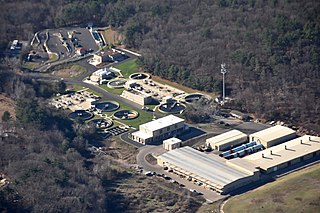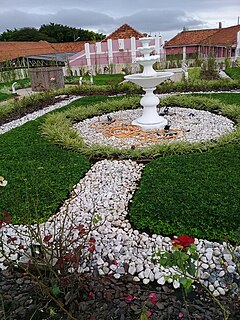Aquafin is a Flemish company, based in Aartselaar, owned by the "Vlaamse Milieuholding", specialized in wastewater treatment and mainly active in Flanders. Jan Goossens is the general manager of Aquafin.

Aartselaar is a municipality located in the Belgian province of Antwerp. The municipality only comprises the town of Aartselaar proper. On January 1, 2006 Aartselaar had a total population of 14,375. The total area is 10.93 km² which gives a population density of 1,316 inhabitants per km². The municipality of Aartselaar is located in the southern outskirts of Antwerp. It is known for its 1801 windmill (Heimolen) as well as the cycling race called Memorial Rik Van Steenbergen.

Wastewater is any water that has been affected by human use. Wastewater is "used water from any combination of domestic, industrial, commercial or agricultural activities, surface runoff or stormwater, and any sewer inflow or sewer infiltration". Therefore, wastewater is a byproduct of domestic, industrial, commercial or agricultural activities. The characteristics of wastewater vary depending on the source. Types of wastewater include: domestic wastewater from households, municipal wastewater from communities and industrial wastewater. Wastewater can contain physical, chemical and biological pollutants.

Flanders is the Dutch-speaking northern portion of Belgium and one of the communities, regions and language areas of Belgium. However, there are several overlapping definitions, including ones related to culture, language, politics and history, and sometimes involving neighbouring countries. The demonym associated with Flanders is Fleming, while the corresponding adjective is Flemish. The official capital of Flanders is Brussels, although the Brussels Capital Region has an independent regional government, and the government of Flanders only oversees the community aspects of Flanders life in Brussels such as (Flemish) culture and education.
The company was established in 1990 by the Flemish government. Its mission is to design, prefinance, build and operate all supra-municipal infrastructure needed to treat domestic wastewater. Nowadays, Aquafin manages 311 wastewater treatment plants, over 6.000 km of supra-municipal collectors and 1.390 pumping stations and detention basins. Aquafin also offers its services for the expansion and management of the local municipal system. A municipality may choose to have a long-term partnership by means of a concession or award contracts to Aquafin on an ad hoc basis. In addition, they can join the joint ventures that Aquafin has with the water companies water-link, De Watergroep (RioAct and Rio-P) and Vivaqua.
Aquafin's subsidiary Aquaplus, focuses in Belgium on the operation of industrial wastewater treatment plants. Internationally, Aquaplus offers technological assistance and conducts a wide range of studies. Abroad the company mostly operates through partners and joint ventures.

Water pollution is the contamination of water bodies, usually as a result of human activities. Water bodies include for example lakes, rivers, oceans, aquifers and groundwater. Water pollution results when contaminants are introduced into the natural environment. For example, releasing inadequately treated wastewater into natural water bodies can lead to degradation of aquatic ecosystems. In turn, this can lead to public health problems for people living downstream. They may use the same polluted river water for drinking or bathing or irrigation. Water pollution is the leading worldwide cause of death and disease, e.g. due to water-borne diseases.

Wastewater treatment is a process used to remove contaminants from wastewater or sewage and convert it into an effluent that can be returned to the water cycle with minimum impact on the environment, or directly reused. The latter is called water reclamation because treated wastewater can then be used for other purposes. The treatment process takes place in a wastewater treatment plant (WWTP), often referred to as a Water Resource Recovery Facility (WRRF) or a Sewage Treatment Plant (STP). Pollutants in municipal wastewater are removed or broken down.
The San Francisco Public Utilities Commission (SFPUC) is a public agency of the City and County of San Francisco that provides water, wastewater, and electric power services to the city and an additional 1.9 million customers within three San Francisco Bay Area counties.

The water industry provides drinking water and wastewater services to residential, commercial, and industrial sectors of the economy. Typically public utilities operate water supply networks. The water industry does not include manufacturers and suppliers of bottled water, which is part of the beverage production and belongs to the food sector.
Onsite sewage facilities (OSSF) are wastewater systems designed to treat and dispose of effluent on the same property that produces the wastewater.

Secondary treatment is a treatment process for wastewater to achieve a certain degree of effluent quality by using a sewage treatment plant with physical phase separation to remove settleable solids and a biological process to remove dissolved and suspended organic compounds. After this kind of treatment, the wastewater may be called as secondary-treated wastewater.

Sewage sludge treatment describes the processes used to manage and dispose of sewage sludge produced during sewage treatment. Sludge is mostly water with lesser amounts of solid material removed from liquid sewage. Primary sludge includes settleable solids removed during primary treatment in primary clarifiers. Secondary sludge separated in secondary clarifiers includes treated sewage sludge from secondary treatment bioreactors.
The Ontario Clean Water Agency (OCWA) is a Crown agency of the Government of Ontario that provides operation, maintenance and management services for more than 450 water and wastewater treatment facilities in the province.
Water supply and sanitation in China is undergoing a massive transition while facing numerous challenges such as rapid urbanization, increasing economic inequality, and the supply of water to rural areas. Water scarcity and pollution also impact access to water.

Sewage treatment is the process of removing contaminants from municipal wastewater, containing mainly household sewage plus some industrial wastewater. Physical, chemical, and biological processes are used to remove contaminants and produce treated wastewater that is safe enough for release into the environment. A by-product of sewage treatment is a semi-solid waste or slurry, called sewage sludge. The sludge has to undergo further treatment before being suitable for disposal or application to land.

The biological treatment of wastewater in the sewage treatment plant is often accomplished using conventional activated sludge systems. These systems generally require large surface areas for treatment and biomass separation units due to the generally poor settling properties of the sludge. Aerobic granules are a type of sludge that can self-immobilize flocs and microorganisms into spherical and strong compact structures. The advantages of aerobic granular sludge are excellent settleability, high biomass retention, simultaneous nutrient removal and tolerance to toxicity. Recent studies show that aerobic granular sludge treatment could be a potentially good method to treat high strength wastewaters with nutrients, toxic substances.
A marine outfall is a pipeline or tunnel that discharges municipal or industrial wastewater, stormwater, combined sewer overflows, cooling water, or brine effluents from water desalination plants to the sea. Usually they discharge under the sea's surface. In the case of municipal wastewater, effluent is often being discharged after having undergone no or only primary treatment, with the intention of using the assimilative capacity of the sea for further treatment. Submarine outfalls are common throughout the world and probably number in the thousands. More than 200 outfalls alone have been listed in a single international database maintained by the Institute for Hydromechanics at Karlsruhe University for the International Association of Hydraulic Engineering and Research (IAHR) / International Water Association (IWA) Committee on Marine Outfall Systems.

Sewage is a type of wastewater that is produced by a community of people. It is characterized by volume or rate of flow, physical condition, chemical and toxic constituents, and its bacteriologic status. It consists mostly of greywater, blackwater ; soaps and detergents; and toilet paper.
Water supply and sanitation in Belgium is provided by a large variety of organizations: Most of the 581 municipalities of Belgium have delegated the responsibility for water supply and sanitation to regional or inter-municipal utilities. There are more than 62 water supply utilities, including 2 regional, 30 inter-municipal and 30 municipal utilities. Another 100 mostly small municipalities provide services directly without having a legally of financially separate entity for water supply. Water is not scarce in Belgium and water supply is generally continuous and of good quality. However, wastewater treatment has long lagged behind and Brussels only achieved full treatment of its wastewater in 2007. In 2004 the European Court of Justice ruled condemning Belgium's failure to comply with the EU wastewater directive, and the ruling has not been fully complied with so far. Wallonia satisfies 55% of the national needs in drinking water while it counts only 37% of the population. Flanders and Brussels are dependent on drinking water from Wallonia, at a level of 40% and 98% respectively.
Veolia Water, is the water division of the French company Veolia Environnement and the world's largest supplier of water services.
Water supply and sanitation in Vietnam is characterized by challenges and achievements. Among the achievements is a substantial increase in access to water supply and sanitation between 1990 and 2010, nearly universal metering, and increased investment in wastewater treatment since 2007. Among the challenges are continued widespread water pollution, poor service quality, low access to improved sanitation in rural areas, poor sustainability of rural water systems, insufficient cost recovery for urban sanitation, and the declining availability of foreign grant and soft loan funding as the Vietnamese economy grows and donors shift to loan financing. The government also promotes increased cost recovery through tariff revenues and has created autonomous water utilities at the provincial level, but the policy has had mixed success as tariff levels remain low and some utilities have engaged in activities outside their mandate.
Atlantic County Utilities Authority (ACUA) is a public agency in Atlantic County, New Jersey, that is responsible for enhancing quality of life through the protection of waters and lands from pollution by providing responsible waste management services.
Sewer mining is a concept where municipal wastewater (sewage) is pumped from a trunk sewer and treated on-site to accommodate a range of local, nonpotable water needs. It is a strategy for combating water scarcity. It combines decentralized wastewater management and water reclamation. Since 2012, it is used as a tool for improving water management and promoting reuse of water in Australia.

Sanepar is a Brazilian water and waste management company owned by Paraná state. It provides water and sewage services to residential, commercial and industrial users in 345 cities and another 293 smaller areas in Paraná and on the city of Porto União, Santa Catarina state. It provides water to 26.7 million customers, or 60% of the population of the state. It is one of the largest water and waste management company in Brazil. It provides basic sanitation services, which include all phases and the collection, treatment and reuse of sewage. It has an 84,600 kilometer network for the withdrawal and distribution of drinking water, for sewage collection and for the discharge of treated sewage. Regarding solid waste, it operates landfills in Apucarana, Cornélio Procópio and Cianorte















